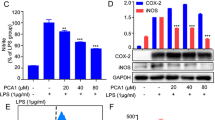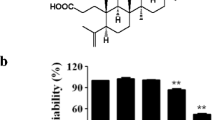Abstract
Macrophages secrete inflammatory cytokines and mono-nitrogen oxide (NO), and play crucial roles in inflammation in early-stage rheumatoid arthritis (RA). This study investigated whether glucosamine hydrochloride (GlcN), a nonsteroidal anti-inflammatory agent (NSAID) widely used to treat arthritis, affects the expression of inflammatory cytokines via the unfolded protein response (UPR) in lipopolysaccharide (LPS)-stimulated mouse macrophages (RAW264.7 cells). Pretreatment with GlcN reduced the expression of inflammatory cytokines and inhibited cell differentiation. Moreover, GlcN treatment increased the expression of CHOP and BiP/Grp78, the UPR target genes, in the presence or absence of LPS. Indeed, knockdown of CHOP using siRNAs prevented the GlcN-mediated reduction of inflammatory cytokines in LPS-stimulated RAW264.7 cells. Finally, we found that GlcN-mediated induction of CHOP reduced the phosphorylation of JNK and NF-?B in LPS-stimulated RAW264.7 cells. Combined, these results suggest that the GlcN-mediated induction of CHOP negatively regulates the inflammatory response by modulating JNK and NF-?B in LPS-stimulated RAW264.7 cells.
Similar content being viewed by others
References
Bodman-Smith MD, Fife MF, Wythe H, Corrigal VM, Panayi GS, Wedderburn LR andWoo P (2004) Anti-BiP antibody levels in juvenile idiopathic arthritis (JIA). Rheumatology (Oxford) 43: 1305–1306.
Cho WS, Lee SG, Jeong M, Cho J andLee K (2008) Visualization of protein-protein interactions between bZIP transcription factors in the unfolded protein response using BiFC analysis. Genes and Genomics 30: 477–485.
Felson DT, Lawrence RC, Hochberg MC, McAlindon T, Dieppe PA, Minor MA, Blair SN, Berman BM, Fries JF, Weinberger M, Lorig KR, Jacobs JJ andGoldberg V (2000) Osteoarthritis: new insights. Part 2: treatment approaches. Ann. Intern. Med. 133: 726–737.
Gotoh T, Oyadomari S, Mori K andMori M (2002) Nitric oxide-induced apoptosis in RAW 264.7 macrophages is mediated by endoplasmic reticulum stress pathway involving ATF6 and CHOP. J. Biol. Chem. 277: 12343–12350.
Gouze JN, Bianchi A, Becuwe P, Dauca M, Netter P, Magdalou J, Terlain B andBordji K (2002) Glucosamine modulates IL-1-induced activation of rat chondrocytes at a receptor level, and by inhibiting the NF-kappa B pathway. FEBS Lett. 510: 166–170.
Hashkes PJ, Friedland O, Jaber L, Cohen HA, Wolach B andUziel Y (2004) Decreased pain threshold in children with growing pains. The Journal of rheumatology 31: 610–613.
Hattori T, Itoh S, Hayashi H, Chiba T, Takii T, Yoshizaki K andOnozaki K (2001) CHOP, a basic leucine zipper transcriptional factor, contributes to the antiproliferative effect of IL-1 on A375 human melanoma cells through augmenting transcription of IL-6. J. Interferon Cytokine Res. 21: 323–332.
Hattori T, Ohoka N, Hayashi H andOnozaki K (2003) C/EBP homologous protein (CHOP) up-regulates IL-6 transcription by trapping negative regulating NF-IL6 isoform. FEBS Lett. 541: 33–39.
Hua J, Sakamoto K andNagaoka I (2002) Inhibitory actions of glucosamine, a therapeutic agent for osteoarthritis, on the functions of neutrophils. J. Leukoc. Biol. 71: 632–640.
Kaufman RJ (1999) Stress signaling from the lumen of the endoplasmic reticulum: coordination of gene transcriptional and translational controls. Genes & development 13: 1211–1233.
Kaufman RJ, Scheuner D, Schroder M, Shen X, Lee K, Liu CY andArnold SM (2002) The unfolded protein response in nutrient sensing and differentiation. Nat. Rev. Mol. Cell Biol. 3: 411–421.
Kim R, Emi M, Tanabe K andMurakami S (2006) Role of the unfolded protein response in cell death. Apoptosis 11: 5–13.
Krappmann D, Wegener E, Sunami Y, Esen M, Thiel A, Mordmuller B andScheidereit C (2004) The IkappaB kinase complex and NF-kappaB act as master regulators of lipopolysaccharide-induced gene expression and control subordinate activation of AP-1. Mol. Cell. Biol. 24: 6488–6500.
Largo R, Alvarez-Soria MA, Diez-Ortego I, Calvo E, Sanchez-Pernaute O, Egido J andHerrero-Beaumont G (2003) Glucosamine inhibits IL-1beta-induced NFkappaB activation in human osteoarthritic chondrocytes. Osteoarthritis Cartilage 11: 290–298.
Lee AK, Sung SH, Kim YC andKim SG (2003) Inhibition of lipopolysaccharide-inducible nitric oxide synthase, TNF-alpha and COX-2 expression by sauchinone effects on I-kappaBalpha phosphorylation, C/ EBP and AP-1 activation. Br. J. Pharmacol. 139: 11–20.
Lee K, Tirasophon W, Shen X, Michalak M, Prywes R, Okada T, Yoshida H, Mori K andKaufman RJ (2002) IRE1-mediated unconventional mRNA splicing and S2P-mediated ATF6 cleavage merge to regulate XBP1 in signaling the unfolded protein response. Genes Dev. 16: 452–466.
Lee SA, Park SH andKim BC (2008) Raloxifene, a selective estrogen receptor modulator, inhibits lipopolysaccharide-induced nitric oxide production by inhibiting the phosphatidylinositol 3-kinase/ Akt/nuclear factor-kappa B pathway in RAW264.7 macrophage cells. Molecules and cells 26: 48–52.
Li Y, Schwabe RF, DeVries-Seimon T, Yao PM, Gerbod-Giannone MC, Tall AR, Davis RJ, Flavell R, Brenner DA andTabas I (2005) Free cholesterol-loaded macrophages are an abundant source of tumor necrosis factoralpha and interleukin-6: model of NF-kappaB- and map kinase-dependent inflammation in advanced atherosclerosis. J. Biol. Chem. 280: 21763–21772.
Libby P (2008) Role of inflammation in atherosclerosis associated with rheumatoid arthritis. The American journal of medicine 121: S21–31.
Lorenz W, Sigrist G, Shakibaei M, Mobasheri A andTrautmann C (2006) A hypothesis for the origin and pathogenesis of rheumatoid diseases. Rheumatol. Int. 26: 641–654.
Ma L, Rudert WA, Harnaha J, Wright M, Machen J, Lakomy R, Qian S, Lu L, Robbins PD, Trucco M andGiannoukakis N (2002) Immunosuppressive effects of glucosamine. J. Biol. Chem. 277: 39343–39349.
McCullough KD, Martindale JL, Klotz LO, Aw TY andHolbrook NJ (2001) Gadd153 sensitizes cells to endoplasmic reticulum stress by down-regulating Bcl2 and perturbing the cellular redox state. Mol. Cell. Biol. 21: 1249–1259.
Mendis E, Kim MM, Rajapakse N andKim SK (2008) Suppression of cytokine production in lipopolysaccharidestimulated mouse macrophages by novel cationic glucosamine derivative involves down-regulation of NF-kappaB and MAPK expressions. Bioorg. Med. Chem. 16: 8390–8396.
Mori K (2000) Tripartite management of unfolded proteins in the endoplasmic reticulum. Cell 101: 451–454.
Nakamura H, Masuko K, Yudoh K, Kato T, Kamada T andKawahara T (2007) Effects of glucosamine administration on patients with rheumatoid arthritis. Rheumatol. Int. 27: 213–218.
Nuki G, Bresnihan B, Bear MB andMcCabe D (2002) Long-term safety and maintenance of clinical improvement following treatment with anakinra (recombinant human interleukin-1 receptor antagonist) in patients with rheumatoid arthritis: extension phase of a randomized, double-blind, placebocontrolled trial. Arthritis Rheum. 46: 2838–2846.
Oyadomari S andMori M (2004) Roles of CHOP/ GADD153 in endoplasmic reticulum stress. Cell death and differentiation 11: 381–389.
Patil C andWalter P (2001) Intracellular signaling from the endoplasmic reticulum to the nucleus: the unfolded protein response in yeast and mammals. Curr. Opin. Cell Biol. 13: 349–355.
Puthalakath H, O'Reilly LA, Gunn P, Lee L, Kelly PN, Huntington ND, Hughes PD, Michalak EM, McKimm-Breschkin J, Motoyama N, Gotoh T, Akira S, Bouillet P andStrasser A (2007) ER stress triggers apoptosis by activating BH3-only protein Bim. Cell 129: 1337–1349.
Qiu W, Kohen-Avramoglu R, Mhapsekar S, Tsai J, Austin RC andAdeli K (2005) Glucosamine-induced endoplasmic reticulum stress promotes ApoB100 degradation: evidence for Grp78-mediated targeting to proteasomal degradation. Arterioscler. Thromb. Vasc. Biol. 25: 571–577.
Rafi MM, Yadav PN andRossi AO (2007) Glucosamine inhibits LPS-induced COX-2 and iNOS expression in mouse macrophage cells (RAW 264.7) by inhibition of p38-MAP kinase and transcription factor NFkappaB. Mol. Nutr. Food Res. 51: 587–593.
Rajapakse N, Kim MM, Mendis E andKim SK (2008) Inhibition of inducible nitric oxide synthase and cyclooxygenase-2 in lipopolysaccharide-stimulated RAW264.7 cells by carboxybutyrylated glucosamine takes place via down-regulation of mitogen-activated protein kinase-mediated nuclear factor-kappaB signaling. Immunology 123: 348–357.
Saxena RK, Vallyathan V andLewis DM (2003) Evidence for lipopolysaccharide-induced differentiation of RAW264.7 murine macrophage cell line into dendritic like cells. Journal of biosciences 28: 129–134.
Scott DL andSteer S (2007) The course of established rheumatoid arthritis. Best practice & research 21: 943–967.
Shikhman AR, Kuhn K, Alaaeddine N andLotz M (2001) N-acetylglucosamine prevents IL-1 beta-mediated activation of human chondrocytes. J. Immunol. 166: 5155–5160.
Sok J, Wang XZ, Batchvarova N, Kuroda M, Harding H andRon D (1999) CHOP-Dependent stress-inducible expression of a novel form of carbonic anhydrase VI. Mol. Cell. Biol. 19: 495–504.
Suyama K, Ohmuraya M, Hirota M, Ozaki N, Ida S, Endo M, Araki K, Gotoh T, Baba H andYamamura K (2008) C/EBP homologous protein is crucial for the acceleration of experimental pancreatitis. Biochem. Biophys. Res. Commun. 367: 176–182.
Vij N, Amoako MO, Mazur S andZeitlin PL (2008) CHOP transcription factor mediates IL-8 signaling in cystic fibrosis bronchial epithelial cells. Am. J. Respir. Cell Mol. Biol. 38: 176–184.
Werstuck GH, Khan MI, Femia G, Kim AJ, Tedesco V, Trigatti B andShi Y (2006) Glucosamine-induced endoplasmic reticulum dysfunction is associated with accelerated atherosclerosis in a hyperglycemic mouse model. Diabetes 55: 93–101.
Yamaguchi H andWang HG (2004) CHOP is involved in endoplasmic reticulum stress-induced apoptosis by enhancing DR5 expression in human carcinoma cells. The Journal of biological chemistry 279: 45495–45502.
Zinszner H, Kuroda M, Wang X, Batchvarova N, Lightfoot, RT, Remotti H, Stevens JL andRon D (1998) CHOP is implicated in programmed cell death in response to impaired function of the endoplasmic reticulum. Genes & development 12: 982–995.
Author information
Authors and Affiliations
Corresponding author
Rights and permissions
About this article
Cite this article
Jeong, M., Cho, J., Cho, WS. et al. The glucosamine-mediated induction of CHOP reduces the expression of inflammatory cytokines by modulating JNK and NF-κB in LPS-stimulated RAW264.7 cells. Genes & Genomics 31, 251–260 (2009). https://doi.org/10.1007/BF03191197
Received:
Accepted:
Issue Date:
DOI: https://doi.org/10.1007/BF03191197




